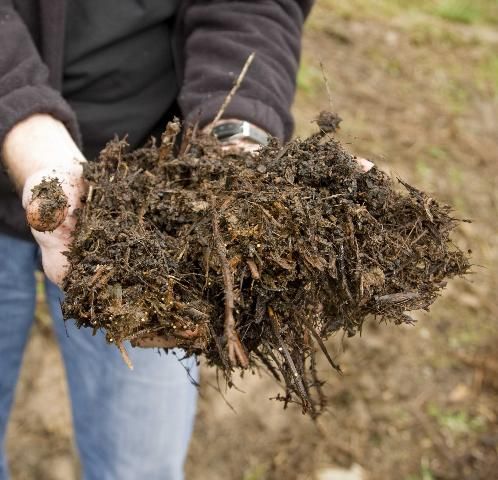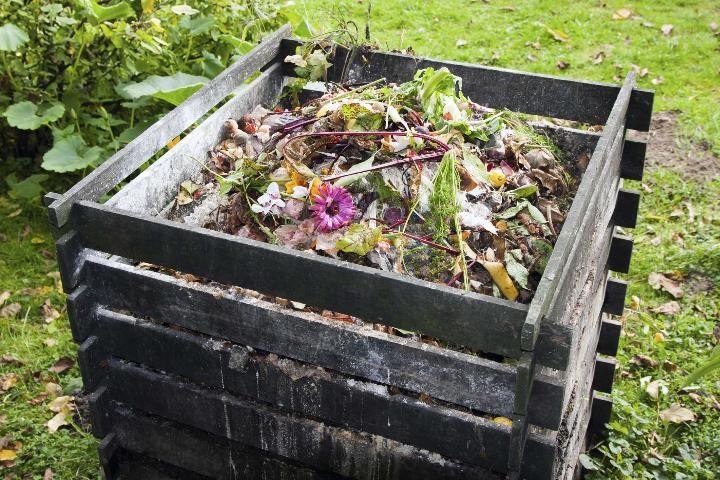What is compost?
Compost is a dark, crumbly material created when microorganisms break down organic matter such as leaves, grass clippings, and kitchen waste. Compost is not completely decomposed (like humus); it will contain small pieces of debris that can be recognized as bits of twigs and leaves (Figure 1).

Credit: Daniel Nel/iStock/Thinkstock
Why compost?
Converting yard and kitchen debris to compost has many benefits. It is an environmentally friendly way to reduce the amount of solid waste that must be disposed of, and it provides useful and beneficial products for yards and gardens. Compost is an excellent soil amendment that improves the health and structure of both sandy and clay soils. It can be applied on top of soil as mulch. Mixed with other components, it makes a good potting soil; some gardeners brew it in water to make a compost "tea" for plants.
What can be composted?
Two types of materials are needed for successful composting: "green" materials, which are rich in nitrogen, and "brown" materials, which are rich in carbon. Table 1 shows the types of materials that are considered "browns" and "greens."
Twigs and branches greater than 1/4 inch in diameter and fibrous palm fronds should be processed in a shredder/chipper before composting. Leaves, especially waxy types such as live oak, laurel oak, water oak, and magnolia, also break down faster if they are shredded. Sawdust and other wood scraps can be composted, but they take a long time to decompose.
Keep seed-laden weeds, diseased plants, and nematode-infested roots out of the compost pile since it is difficult for most home composting units to reach the high temperatures (130–140°F) needed to destroy these pests. Meat, bones, and foods with oils, dressings, or fats should not be composted because they may attract animals or produce an objectionable odor. The manure of animals that eat plants (cows, horses, etc.) is a great "green" material for a compost pile. Avoid manures from animals that have grazed on or been fed forage treated with herbicides (see EDIS publication AG416 Herbicide Residues in Manure, Compost, or Hay https://edis.ifas.ufl.edu/publication/AG416). The waste of carnivorous animals (dogs, cats, etc.) should also not be used due to the possibility of diseases.
Building a Compost Pile
Composting is all about supplying the microorganisms that do the decomposing with the essentials of life: food, water, and oxygen. Microbial activity is affected by the proportion of carbon (brown materials) to nitrogen (green materials). This is commonly referred to as the C/N ratio. The optimum C/N ratio for rapid composting is about 30/1 or less. Table 2 lists the approximate C/N ratio for materials commonly used for composting.
A compost pile or unit should be sited in an area protected from drying winds and where it can be reached with a hose. Place it in a shaded area where you will be more comfortable when you "work" it. Depending on what type of compost "unit" you buy or build, you may want it screened from view of neighbors and yourself. Keep in mind that there is nothing magical about commercial compost units; they are simply holding units and will not produce compost any faster or better than a simple pile. The most important feature is that the pile or unit be a minimum of 3' x 3' x 3' to generate and retain heat (Figure 2).

Credit: piotr_malczyk/iStock/Thinkstock
For more information on compost bins, refer to http://sarasota.ifas.ufl.edu/compost/compost-bins.shtml or your local UF/IFAS Extension office (https://sfyl.ifas.ufl.edu/find-your-local-office/).
To create the compost pile, layer roughly equal amounts of "green" materials and "brown" materials in alternating 3- to 4-inch tiers up to a height of about 3 feet. Smaller particles will decompose faster than larger materials. It is essential that each layer be watered as you build the pile; otherwise, it is almost impossible to moisten the center of the pile once it is completed. The materials should be moist, not soggy. There is no advantage to purchasing a compost "starter," since organic yard wastes naturally contain the microorganisms needed to start the decomposition process.
Managing a Compost Pile
A new pile of green and brown materials will heat up rapidly. This is a reflection of the microbial activity. After 4–7 days, it will begin to cool and should be turned at this time to mix the materials and allow the pile to heat again. A hot pile will often produce steam, but this is not a concern. Compost can be produced fairly rapidly (about six weeks) if the pile is occasionally turned and watered (if dry). Turning also shifts material from the outer (cooler) part of the pile to the warmer center. It may be necessary to add more water during the composting period if the pile appears dry. Materials added to a compost pile or unit which is not turned or watered will still decompose. It will just take much longer.
If you are interested in monitoring the temperature of the pile, use a long-stemmed compost thermometer that reads to 160°F or higher. The most effective range for composting seems to be 122°F–131°F. Higher temperatures of 131°F–140°F may be desirable to destroy weed seeds or plant pathogens, but it is difficult to maintain a pile at that temperature. At temperatures above 149°F, many of the organisms involved in composting become inactive or die. If the pile becomes too hot, decrease the intervals between turnings.
How to Use Compost
Compost is ready to use when it is dark brown and crumbly (Figure 3). If the texture is not uniform, the compost can be sifted through a screen to remove larger pieces, which can then be returned to the pile for further composting.

Credit: Alex Raths/iStock/Thinkstock
Compost is a wonderful soil additive—especially to Florida's poor, sandy soils. Use only finished compost as a soil amendment. Otherwise, microorganisms will "rob" nutrients from plants as they continue to decompose the unfinished compost. Add 1–3 inches of compost to the soil surface and mix it to a depth of 4–6 inches.
Compost can also be used as mulch. This is a particularly good use of unfinished compost. It will continue to break down, and, like all mulches, will need to be re-applied once or twice a year.
As a potting mix, use only finished compost and blend it with a material that improves the drainage of the mix such as coarse sand, perlite, or vermiculite. Compost tea is made by steeping mature compost in water in a bag made of cheesecloth, burlap, or some other woven fabric. It is frequently touted as a liquid fertilizer and/or as a disease suppressant when sprayed on leaves or drenched onto the soil. In truth, compost tea does not provide a measurable amount of nutrients to plants. Similarly, studies on the effectiveness of compost tea as a disease suppressant are variable and inconclusive. There are also concerns the tea could contain pathogens dangerous to human health.
Troubleshooting a Compost Pile
Table 3 provides information on common composting problems, their causes, and how to solve them. For more information on composting, contact your local UF/IFAS Extension office: https://sfyl.ifas.ufl.edu/find-your-local-office/.
References
Composting Webpage. UF/IFAS Extension Sarasota County. http://sarasota.ifas.ufl.edu/compost
Freeman, et.al. 2021. Recycling Organic Materials to Improve Your Florida-Friendly Edible Landscape. ENH1335. Gainesville: University of Florida Institute of Food and Agricultural Sciences. https://edis.ifas.ufl.edu/publication/EP599
Treadwell, D. D., S. P. Brown, J. Stephens, and S. Webb. 2017. Organic Vegetable Gardening in Florida. HS1215. Gainesville: University of Florida Institute of Food and Agricultural Sciences. https://edis.ifas.ufl.edu/hs1215